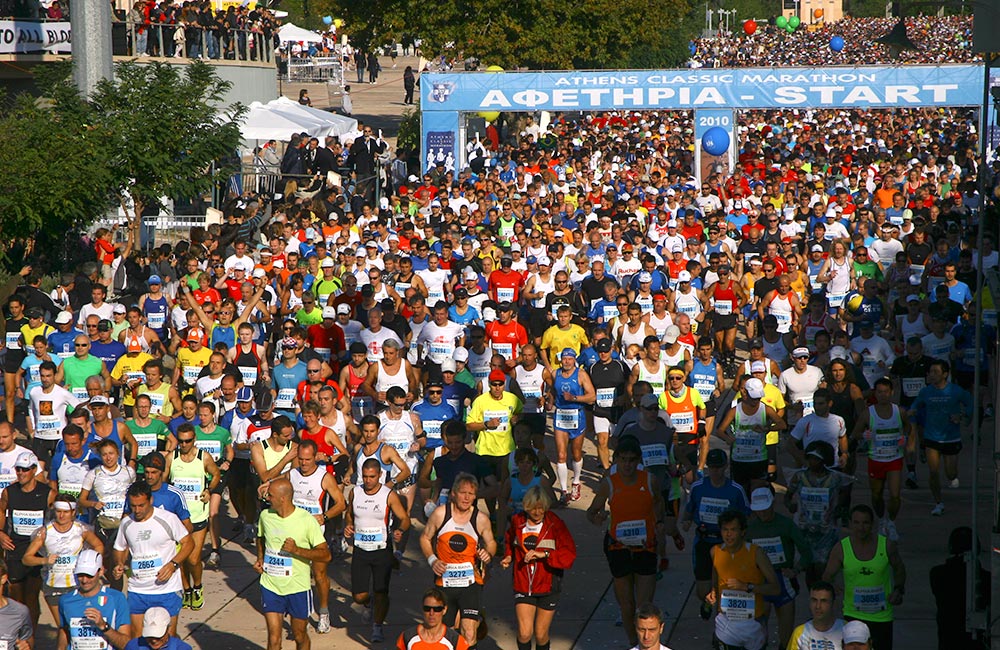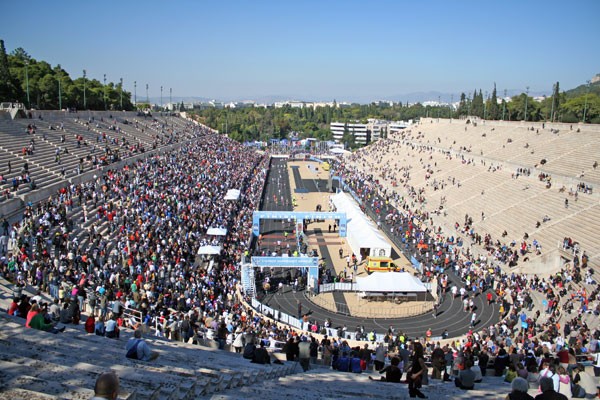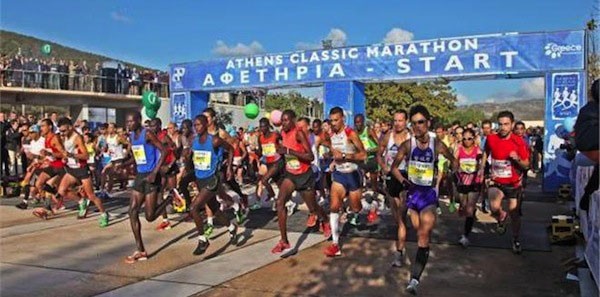Athens Classic Marathon
The Athens Marathon (Greek Κλασσικός Μαραθωνίος Αθηνών; . Engl name Athens Classic Marathon ) is a marathon, which runs from Marathon to Athens. This takes place in its present form has been held since 1983, first in October, currently in November, and is organized by the Greek athletics federation SEGAS. The program also includes a 5-km and 10 - km run. With around 3,000 Zieleinläufern it is the largest marathon in South Eastern Europe.
History
The first marathon of the modern era took place on the occasion of the Olympic Games in 1896. This was based on the legend of the messenger Pheidippides runners, which should be run after the battle of Marathon in 490 BC after Athens and collapsed dead on the Areopagus after the announcement of the news of victory from exhaustion. Winners of the competition was the Greek Spyridon Louis in 2:58:50 h Length of the route at that time was about 40 km. It was not until 1921, certain of the International Association of Athletics Federations IAAF official length of marathon runs with 42,195 kilometers, which corresponds to the distance at the Olympic Games 1908 in London.
After 1896 until the 1950s, not a marathon run was more organized in Athens. From 1955, a marathon in the spring and one in autumn since 1974 took place. In the former event 1969, the English Bill Adcocks ran with 2:11:07,2 h, a time that was on the route from Marathon to Athens since then, undercut only by Stefano Baldini, the Olympic champion from 2004.
The current event is dedicated to the memory of athletes, physician and politician Grigoris Lambrakis. This organized shortly before his assassination in 1963 a peace march from Marathon to Athens. The demonstration was banned by the police, so that Lambrakis, protected by his parliamentary immunity, alone made her way.
At the European Athletics Championships in 1982 for the first time the title of European Champion in the marathon was awarded for females. On the route from Marathon to Athens, the Portuguese Rosa Mota won in 2:36:04 h; among men, the Dutchman Gerard Nijboer prevailed in 2:15:16 h. On April 9, 1995, the last World Cup Marathon IAAF has also played on the route of the Athens Marathon. Winners were Kenyan Douglas Wakiihuri in 2:12:01 h and the Romanian Anuta Catuna in 2:31:10 h, as the marathons in the World Athletics Championships in 1997 and 2004 Olympic Games, followed the classic route. World Champion was the Spaniard Abel Antón in 2:13:16 h and the Japanese Hiromi Suzuki in 2:29:48 h, the Olympic gold medals were won by the Italian Stefano Baldini ( 2:10:55 h) and the Japanese Mizuki Noguchi (2: 26:20 h).
The discharge 2010 was embedded in the celebrations for the anniversary of the Battle of Marathon 2500jährigen.
Route
The route begins in the village of Marathon and leads first to the south, where the grave mound of the fallen in the battle of Marathon Athens is surrounded. After the town of Nea Makri is crossed. After ten flat kilometers now come the first ascents. In Rafina the course turns to the west, and on Pikermi, Pallini and Gerakas one arrives at 32 km to Agia Paraskevi, where 240 m above sea level, the highest point of the track is reached. From there it goes downhill through Chalandri and Cholargos in the core city of Athens. The target is located in the Ancient Stadium.
Statistics
List of winners
- Track records
Development of finishers Ahlen
Highlights: Record values










